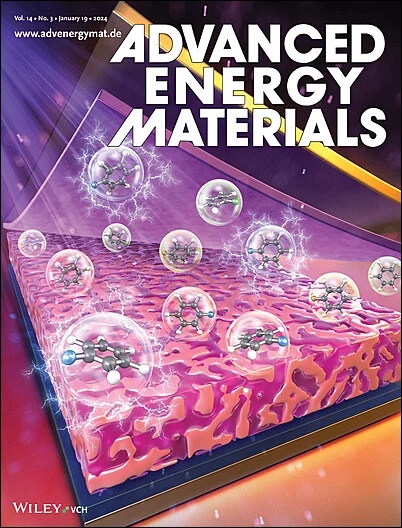Synergistic Passivation for Efficient Inverted Inorganic Perovskite Solar Cells
IF 24.4
1区 材料科学
Q1 CHEMISTRY, PHYSICAL
引用次数: 0
Abstract
Inorganic perovskites possess a bandgap compatible with silicon for tandem solar cells without excessive halide doping, and they also exhibit excellent thermal stability. However, interfacial defects and energy losses caused by energy level mismatch hinder the development of efficient inverted inorganic perovskite solar cells (PSCs). To address this issue, a multifunctional small molecule, S‐(2‐aminoethyl) isothiouronium bromide hydrobromide (SPD), which simultaneously achieves chemical and field passivation at the CsPbI高效倒置无机钙钛矿太阳能电池的协同钝化
无机钙钛矿在没有过量卤化物掺杂的情况下,具有与硅兼容的带隙,并且具有优异的热稳定性。然而,界面缺陷和能量失配导致的能量损失阻碍了高效倒置无机钙钛矿太阳能电池(PSCs)的发展。为了解决这一问题,一种多功能小分子S‐(2‐氨基乙基)异硫脲溴化氢溴化物(SPD)在CsPbI2.85Br0.15/电子传输层(PVK/ETL)界面上同时实现了化学和场钝化。SPD含有供电子氨基(AG)和硫羰基(TG),能够与欠配位Pb2 +离子强配位,实现化学钝化。同时,该分子中的阳离子表现出显著的偶极矩,这调节了界面电场分布,从而抑制了界面上载流子的重组。SPD在钙钛矿表面的掺入显著减少了非辐射复合,抑制了迟滞,并改善了载流子的提取。SPD修饰的无机PSCs在1.268 V电压下实现了21.15%的一流功率转换效率(PCE),将开路电压(VOC)损失降低到452 mV。未封装器件在65℃热老化600 h下效率保持82.13%,连续照明200 h后效率保持92.54%。
本文章由计算机程序翻译,如有差异,请以英文原文为准。
求助全文
约1分钟内获得全文
求助全文
来源期刊

Advanced Energy Materials
CHEMISTRY, PHYSICAL-ENERGY & FUELS
CiteScore
41.90
自引率
4.00%
发文量
889
审稿时长
1.4 months
期刊介绍:
Established in 2011, Advanced Energy Materials is an international, interdisciplinary, English-language journal that focuses on materials used in energy harvesting, conversion, and storage. It is regarded as a top-quality journal alongside Advanced Materials, Advanced Functional Materials, and Small.
With a 2022 Impact Factor of 27.8, Advanced Energy Materials is considered a prime source for the best energy-related research. The journal covers a wide range of topics in energy-related research, including organic and inorganic photovoltaics, batteries and supercapacitors, fuel cells, hydrogen generation and storage, thermoelectrics, water splitting and photocatalysis, solar fuels and thermosolar power, magnetocalorics, and piezoelectronics.
The readership of Advanced Energy Materials includes materials scientists, chemists, physicists, and engineers in both academia and industry. The journal is indexed in various databases and collections, such as Advanced Technologies & Aerospace Database, FIZ Karlsruhe, INSPEC (IET), Science Citation Index Expanded, Technology Collection, and Web of Science, among others.
 求助内容:
求助内容: 应助结果提醒方式:
应助结果提醒方式:


